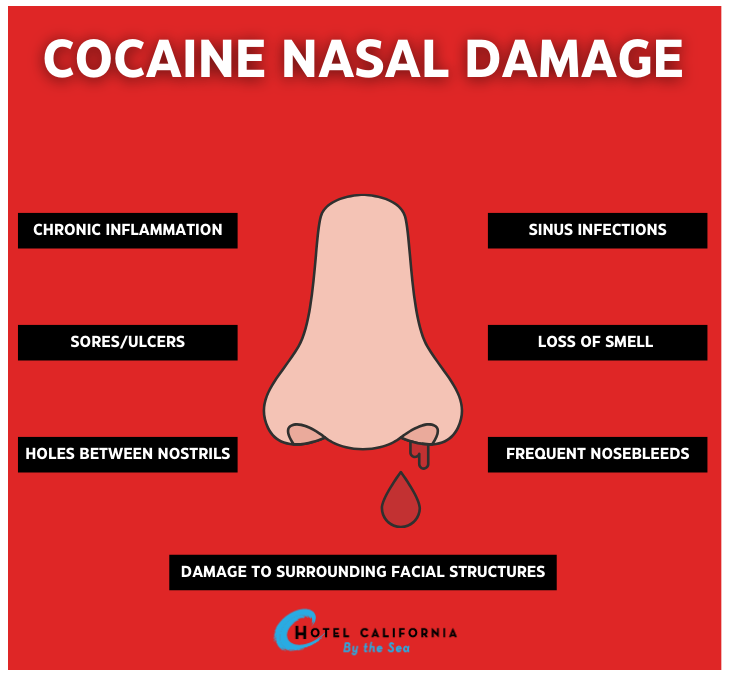Cocaine Nose Damage
Cocaine is one of the most addictive substances often used recreationally to produce feelings of short-term euphoria, hyperactivity, and increased energy levels. The addictive stimulant is derived from the leaves of plants native to the South American region. Misusing or abusing cocaine can lead to dangerous side effects such as cardiac damage, increased blood pressure, and chronic nasal damage if the drug is administered intranasally.

The drug’s popularity for recreational use has resulted in many different methods of administration. One common method is snorting or inhalation of the drug through the nasal passageway. Snorting any type of substance can cause damage not only to the nose but also to other internal systems. Snorting cocaine allows the drug to be quickly absorbed directly into the body through the blood vessels inside the nose. Compared to inhaling the drug, which can take longer for the drug to take effect. A high produced from snorting cocaine can last 15-30 minutes compared to a high from smoking, which only lasts between 5-10 minutes. In order to sustain that high, users often use the drug in a binge pattern and repeatedly take the drug within a short time frame in order to prolong the effects. This leads to addiction and dangerous effects on the nasal structure.
The direct contact between cocaine and nasal tissue can cause serious damage and injury that can begin as soon as the very first time a user snorts the stimulant. Even after snorting cocaine just a few times, it can significantly impact the nasal structure. It can cause damage and even death to very delicate nasal cells. Powder inhalation of cocaine is the main cause of cocaine nose damage which includes nasal septum injury and septal perforation. In extreme cases, even users with serious nasal injuries will continue to snort cocaine and get high because of their physical and psychological addiction.
Why is Snorting Cocaine so dangerous?
The inside of our noses is covered in a tissue called nasal mucosa. This tissue is very delicate and it helps to moisten the air when you breathe as it travels into your lungs. It produces mucus to keep your nasal passageways lubricated. It also contains specialized cells that help you smell. The nose is a very important anatomy of the body’s system. When snorting cocaine through the nose, it can cause all kinds of dangerous side effects that impact the nasal system as well as other bodily systems.
Cocaine is a controlled substance and is most often used illegally and recreationally. Because of that, users are often buying the drug on the street market. Cocaine is often cut or mixed with other unknown substances and ingredients which can be very harmful to the nasal mucosa. Most often, the cocaine you are buying off the street is not pure. When it is mixed with other ingredients, cocaine can also produce a certain type of acid, which again can cause damage to the nasal passageways. A 2015 study found that cocaine had an average pH of 3.5. This makes it just as acidic as orange juice. This highly acidic substance will irritate your nasal mucosa, causing damage to the tissue and its ability to keep out foreign particles and bacteria from entering your body.
Ultimately, long-term snorting of cocaine can lead to damage to even deeper structures of the nose such as the cartilage and bones. In some cases, it can cause the nose to collapse completely. When this happens, some damages cannot even be repaired with surgery.

Dangers of Cocaine nose damage
- Nosebleeds. Repeated cocaine use nasally triggers nosebleeds. Nosebleeds occur when cocaine directly damages the nasal mucosa, leaving the blood vessels exposed and more prone to breakage. Less blood can also get to the nasal mucosa. The nasal mucosa needs nutrients carried by blood to repair damage and repair itself. In the event that it cannot self-repair, it will continue to break down, leading to a bloody nose.
- Loss of smell. Olfactory cells are the specialized cells within the nose that allow us to detect different odors and pass on those signals to the brain that are interpreted as different smells. Damage to these cells can lead to a medical condition called anosmia, where you are unable to smell properly and can even lead to loss of smell completely. Some are able to regain their smell sense back after they stop using cocaine, but in extreme cases, some are not.
- Pain. Cocaine is an acidic drug. Snoring any type of acidic substance through your nose can easily irritate it and cause damage to the nasal lining. The irritation leads to inflammation, which can cause pain. Cocaine can also temporarily numb the nasal mucosa and many people are not able to feel the pain in real time and continue to use the drug causing more injury. Inflammation of the nasal mucosa means it is unable to keep out bacteria and viruses leading to the development of sinus infections and facial pain.
- Chronic nasal congestion. When the nasal mucosa is damaged, it will no longer be able to regulate itself and control its mucus production. This leads to chronic runny nose or chronic stuffy nose.
- Ulcers. Constant nasal injury due to snorting cocaine can lead to nasal ulcers. Ulcers are painful breakdowns of tissue inside the nose that do not heal easily. The lack of blood flow blocked from the cocaine-induced blood constriction makes it more difficult to self-repair. Ulcers can also reach into deep structures of the nose making you more prone to develop other types of infections.
- Septal perforation. A septal perforation is a severe complication of the nose that occurs due to long-term damage of cartilage and bony structure of the nose. A physical hole will develop inside the nasal cartilage. Other types of nasal septum damage can lead to nasal deformities such as saddle nose deformity and even complete nasal collapse. This is also known as having a cocaine nose or coke nose. The initial symptoms of coke nose include swelling, dryness, nosebleeds and runny or stuffy nose. In some cases, medical attention such as plastic surgery can help repair the nose damage.
- Infections. There are bones in our noses that separate the sinuses and other structures of the nose. When these structures break down, it can lead to bacteria and viruses infiltrating the sinuses and causing infection.
Check Your Insurance Coverage for FREE
Find out if your insurance covers addiction treatment in minutes. We accept most insurance!
How to avoid Cocaine damage to the nose
Ultimately the only way to guarantee nose damage from cocaine is to stop using the drug completely. However, there are a few things you can do to help treat cocaine nose damage and prevent further and more serious complications.
- Apply a small amount of petroleum jelly around the edge of the nostril and a small amount inside the nose to prevent cocaine from fully penetrating the nasal cells inside the nasal lining.
- Use a saline rise after you snort because the cocaine can remain on the nasal mucosa for several minutes after you use the drug.
- Alternate using different nostrils to avoid too much damage to one side.
Reach out to Hotel California by the Sea
We specialize in treating addiction and other co-occurring disorders, such as PTSD. Our Admissions specialists are available to walk you through the best options for treating your addiction.
Treatment for Cocaine Addiction
Cocaine is a powerful and highly addictive stimulant that is often snorted. Regular snorting of cocaine can lead to loss of smell, nosebleeds, chronic runny nose, nasal congestion, sinusitis, nasal obstruction, foul-smelling nasal odor or discharge, nasal deformity and even complete nasal collapse. Because cocaine is so powerful it can easily cause an addiction in which the user will continue to snort despite dangerous nasal side effects. Treatment programs such as Hotel California by the Sea, provide a comprehensive approach to substance use disorder.
We offer treatment at all levels of care including detox, residential and outpatient treatment. We specialize in substance use disorders including a specialized program for stimulant addiction and abuse. Clients can expect evidence-based treatment methods such as CBT, DBT and mediation-assisted treatments. Hotel California by the Sea is dedicated to helping our clients reach their goal of sobriety and recovery from drugs and alcohol.
References:
https://www.goodrx.com/well-being/substance-use/what-does-cocaine-do-to-your-nose
https://www.bbc.com/news/uk-scotland-glasgow-west-64901125
https://www.healthline.com/health/substance-use/vaseline-for-coke-nose
https://zinniahealth.com/substance-use/cocaine/nose
https://www.doctorwalton.com/procedures/nose-procedures/cocaine-nose/
https://perforatedseptum.com/cocaine-nose-treatment/
